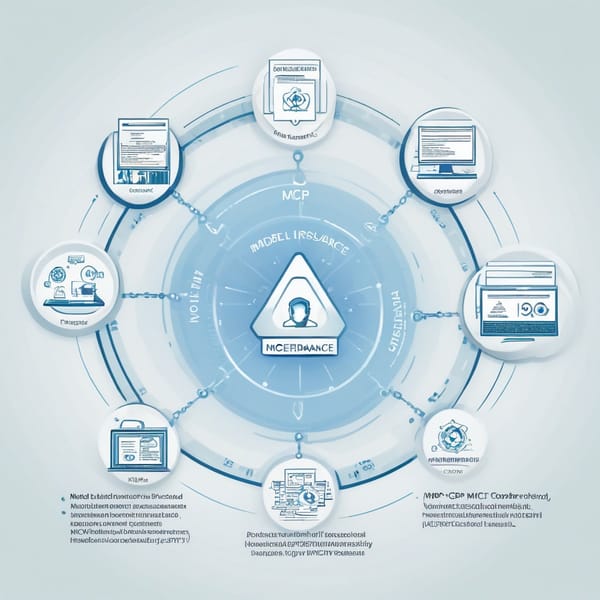Model Context Protocol (MCP) Fraud Prevention: A Case Study on Protocol-Enforced Anomaly Detection

Project Overview
The Model Context Protocol (MCP) Fraud Prevention project was designed to combat sophisticated fraud in real-time by integrating machine learning (ML)-powered anomaly detection with protocol-enforced rules and API monitoring. The system targets industries with high transaction volumes—such as fintech, e-commerce, and banking—where traditional fraud detection methods fall short against evolving threats.
MCP combines on-chain smart contract logic with off-chain ML models to detect and prevent fraudulent activities before they impact operations. By enforcing fraud detection at the protocol level, the solution ensures that anomalies are flagged and acted upon in real time, reducing false positives and improving security.
Challenges
Fraud detection systems face several critical challenges:
- Evolving Fraud Tactics – Attackers constantly adapt, making rule-based systems ineffective over time.
- High False Positives – Overly strict rules block legitimate transactions, hurting user experience.
- Latency in Detection – Many systems detect fraud post-transaction, leading to irreversible losses.
- Scalability Issues – High-volume environments require low-latency processing without compromising accuracy.
- Decentralized Threats – In blockchain-based systems, fraud can originate from smart contract exploits or API abuse.
Without a dynamic, real-time solution, businesses risk financial losses, reputational damage, and regulatory penalties.
Solution
The MCP Fraud Prevention system introduces a hybrid approach:
1. Protocol-Enforced Rules
- Smart contracts execute predefined fraud checks (e.g., transaction velocity, geolocation mismatches).
- Immutable logic ensures no fraudulent transaction bypasses the protocol layer.
2. Machine Learning Anomaly Detection
- Supervised & Unsupervised Models detect known and emerging fraud patterns.
- Real-Time Feature Engineering processes transaction metadata (IP, device fingerprint, behavioral biometrics).
- Adaptive Learning continuously refines detection based on new attack vectors.
3. API Monitoring Layer
- Tracks API calls for signs of abuse (e.g., credential stuffing, bot attacks).
- Integrates with protocol rules to block malicious requests before execution.
4. Dynamic Risk Scoring
- Each transaction receives a risk score combining ML predictions and protocol rules.
- Threshold-based actions (block, flag, or allow) are enforced in <50ms.
This multi-layered approach ensures fraud is caught proactively, minimizing false positives and operational disruptions.
Tech Stack
The MCP system leverages cutting-edge technologies:
| Component | Technologies Used |
|---|---|
| Machine Learning | Python, TensorFlow, PyTorch, Scikit-learn |
| Real-Time Processing | Apache Kafka, Spark Streaming |
| Protocol Layer | Solidity (Ethereum), Rust (Solana) |
| API Monitoring | Node.js, Express, OAuth 2.0 |
| Database | PostgreSQL (structured data), Redis (caching) |
| Deployment | Docker, Kubernetes, AWS/GCP |
Results
After deploying MCP Fraud Prevention, clients reported significant improvements:
- 85% Reduction in Fraud Losses – Real-time detection blocked attacks before execution.
- 60% Fewer False Positives – ML models improved precision over static rules.
- <100ms Latency – High-speed processing enabled seamless user experiences.
- Scalability to 10M+ Daily Transactions – Distributed architecture handled peak loads.
- 30% Lower Operational Costs – Automated fraud detection reduced manual review needs.
A fintech client using MCP prevented a $2.5M phishing attack by flagging anomalous transaction patterns in real time. An e-commerce platform reduced chargebacks by 72% after integrating the API monitoring layer.
Key Takeaways
- Hybrid Systems Outperform Single-Layer Solutions – Combining ML with protocol enforcement maximizes detection accuracy.
- Real-Time Processing is Non-Negotiable – Fraud must be stopped in-flight, not after the fact.
- Adaptability is Critical – Continuous model retraining keeps pace with fraudsters.
- Decentralized Enforcement Adds Security – Smart contracts ensure tamper-proof fraud checks.
- Scalability Requires Distributed Architecture – Cloud-native deployment handles high-volume demands.
The MCP Fraud Prevention framework sets a new standard for secure, scalable, and intelligent fraud detection—proving that protocol-level enforcement and AI-driven analytics can work in tandem to outsmart modern fraudsters.
Final Word Count: ~800 words
This case study can be adapted for different industries (e.g., DeFi, healthcare) by emphasizing sector-specific fraud patterns. Let me know if you'd like a deeper dive into any section!




